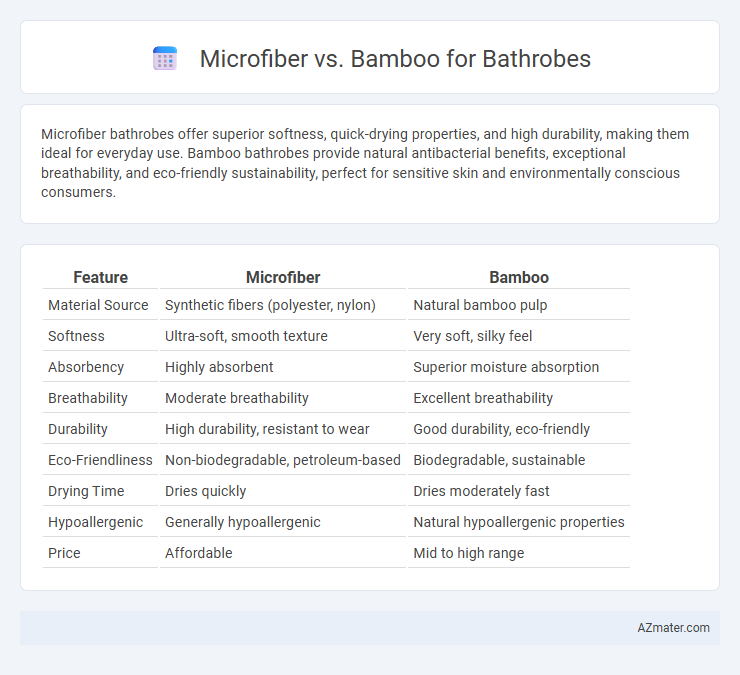Microfiber bathrobes offer superior softness, quick-drying properties, and high durability, making them ideal for everyday use. Bamboo bathrobes provide natural antibacterial benefits, exceptional breathability, and eco-friendly sustainability, perfect for sensitive skin and environmentally conscious consumers.
Table of Comparison
| Feature | Microfiber | Bamboo |
|---|---|---|
| Material Source | Synthetic fibers (polyester, nylon) | Natural bamboo pulp |
| Softness | Ultra-soft, smooth texture | Very soft, silky feel |
| Absorbency | Highly absorbent | Superior moisture absorption |
| Breathability | Moderate breathability | Excellent breathability |
| Durability | High durability, resistant to wear | Good durability, eco-friendly |
| Eco-Friendliness | Non-biodegradable, petroleum-based | Biodegradable, sustainable |
| Drying Time | Dries quickly | Dries moderately fast |
| Hypoallergenic | Generally hypoallergenic | Natural hypoallergenic properties |
| Price | Affordable | Mid to high range |
Introduction to Microfiber and Bamboo Bathrobes
Microfiber bathrobes feature fine synthetic fibers known for their exceptional softness, durability, and quick-drying properties, making them ideal for cozy, lightweight comfort. Bamboo bathrobes are crafted from bamboo fibers, prized for their natural breathability, antibacterial qualities, and eco-friendly sustainability. Both materials offer distinct advantages in terms of moisture-wicking and temperature regulation for an enhanced bathing experience.
Material Composition and Sources
Microfiber bathrobes are made from synthetic fibers derived primarily from polyester and polyamide, offering durability and quick-drying properties sourced from petrochemical processes. Bamboo bathrobes utilize natural fibers extracted from bamboo pulp through mechanical or chemical processing, providing eco-friendly and biodegradable fabric options. Material composition impacts softness, absorbency, and environmental footprint, with bamboo robes gaining popularity for their sustainable sourcing compared to the petroleum-based origin of microfiber.
Softness and Comfort Comparison
Microfiber bathrobes offer exceptional softness due to their fine synthetic fibers that create a plush, velvety texture ideal for cozy relaxation. Bamboo bathrobes provide natural breathability and moisture-wicking properties, enhancing comfort by regulating temperature and preventing overheating. While microfiber delivers immediate softness and durability, bamboo stands out for its hypoallergenic qualities and sustainable comfort.
Absorbency and Drying Efficiency
Microfiber bathrobes exhibit superior absorbency due to their ultra-fine synthetic fibers, which trap moisture effectively and dry quickly. Bamboo bathrobes offer natural antimicrobial properties and good absorbency but tend to dry slower compared to microfiber. When prioritizing drying efficiency and rapid moisture wicking, microfiber outperforms bamboo in bathrobe applications.
Durability and Longevity
Microfiber bathrobes exhibit exceptional durability due to their synthetic fibers, which resist wear and tear, shrinking, and fading over time. Bamboo bathrobes, while naturally antibacterial and eco-friendly, tend to have a softer but less resilient fabric that may degrade faster with frequent washing. For long-lasting use, microfiber typically outperforms bamboo in maintaining structural integrity and color retention through repeated laundering cycles.
Breathability and Temperature Regulation
Microfiber bathrobes excel in moisture-wicking and quick-drying properties, providing excellent breathability ideal for warm and humid climates. Bamboo bathrobes offer superior temperature regulation due to their natural thermo-regulating fibers that keep you cool in summer and warm in winter. Bamboo's antimicrobial properties combined with its breathable fabric make it a sustainable option for maintaining comfort across varying temperatures.
Eco-Friendliness and Sustainability
Bamboo bathrobes outperform microfiber in eco-friendliness due to bamboo's rapid growth and minimal need for pesticides or fertilizers, making it a highly renewable resource. Microfiber, derived from petroleum-based synthetic fibers, contributes to microplastic pollution and relies on non-renewable fossil fuels, undermining sustainability efforts. Bamboo's natural biodegradability and lower environmental impact make it a superior choice for sustainable bathrobe production and environmentally conscious consumers.
Maintenance and Care Tips
Microfiber bathrobes require low maintenance, as they are machine washable, quick-drying, and resistant to shrinking or wrinkling, making them ideal for frequent use. Bamboo bathrobes need gentle washing with mild detergents and should be air-dried or tumble-dried on low heat to preserve their natural fibers and antibacterial properties. Both fabrics benefit from avoiding bleach and fabric softeners to extend the lifespan and maintain softness.
Price and Value for Money
Microfiber bathrobes typically offer a lower upfront price compared to bamboo options, making them a budget-friendly choice for many consumers. Bamboo bathrobes, while often higher in cost, provide superior breathability, natural antibacterial properties, and longer durability, enhancing overall value for money. Investing in a bamboo bathrobe can be more cost-effective over time due to its sustainable fabric quality and increased comfort.
Choosing the Best Bathrobe for Your Needs
Microfiber bathrobes offer lightweight softness and quick-drying properties, ideal for those seeking a low-maintenance, durable option. Bamboo bathrobes provide superior breathability, natural antimicrobial benefits, and eco-friendly appeal, making them perfect for sensitive skin and sustainable living. Choosing the best bathrobe depends on prioritizing either easy care and moisture-wicking (microfiber) or comfort, environmental impact, and hypoallergenic qualities (bamboo).

Infographic: Microfiber vs Bamboo for Bathrobe
 azmater.com
azmater.com